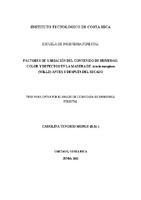Factores de variación del contenido de humedad, color y defectos en la madera de Acacia mangium (Willd) antes y después del secado
Abstract
Acacia mangium is an important specie planted in Costa Rica. However, the wood uses
have been limited by drying problems such as high initial moisture content (CHi), a high
variability of final moisture content (CHf), wood color variation in heartwood and a high
presence of drying defects. The aim objective of this research was investigated the causes
of these problems. It was considered climatic conditions where tree growth, height of the
tree, grain pattern, drying schedules, distance from pith and sapwood or heartwood
presence. The results showed a CHi averaged of 127% and its variation was from 58 to
186%. The variation of CHi was influenced by climatic conditions, tree height and grain
pattern. The MCf averaged was 19% and varied from 9 to 52%. The lack of uniformity in
the CHf after drying is influenced by tree height, drying schedule and the interaction of
both factors. Also, it was found that wet pockets are development during drying. The
lumber from trees growing in humid tropical climates, drying processes with low relative
humidity in kiln dry and sawn timber with rift sawn or double rift sawn is likely to develop
wet pocket. The wood color change during drying and its changed was affected by the
drying schedule and climatic conditions. Drying defects and shrinkages are classified as
nulls or likely present and they were affected by climate, grain pattern, the CHi and CHf,
and drying schedule.
Description
Proyecto de Graduación (Licenciatura en Ingeniería Forestal) Instituto Tecnológico de Costa Rica, Escuela de Ingeniería Forestal, 2011.


